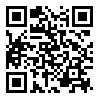Volume 6, Issue 2 (Vol6,No2(20) 2025)
2025, 6(2): 0-0 |
Back to browse issues page
Ethics code: 0
Download citation:
BibTeX | RIS | EndNote | Medlars | ProCite | Reference Manager | RefWorks
Send citation to:



BibTeX | RIS | EndNote | Medlars | ProCite | Reference Manager | RefWorks
Send citation to:
Salimi keleshteri B, Salehi komroodi M, Kargar khorami F, Jafari S. (2025). Relationship between the duration of working with digital screens with autism symptoms and psycho-motor development coefficient in children with and without autism spectrum disorder. Journal of Childhood Health and Education. 6(2),
URL: http://jeche.ir/article-1-324-en.html
URL: http://jeche.ir/article-1-324-en.html
1- B.Sc. in Exceptional Educational Sciences, Faculty of Educational Sciences and Psychology, USWR, Tehran, Iran
2- M.Sc. in Psychology and Education of Exceptional Children, Faculty of Educational Sciences and Psychology, Azarbaijan Shahid Madani University, Tabriz, Iran
3- M.Sc. in Educational Sciences of Preschool and Elementary Education, Faculty of Educational Sciences and Psychology, USWR, Tehran, Iran.
4- B.Sc. in Psychology, Faculty of Educational Sciences and Psychology, Taft PNU, Yazd, Iran.
2- M.Sc. in Psychology and Education of Exceptional Children, Faculty of Educational Sciences and Psychology, Azarbaijan Shahid Madani University, Tabriz, Iran
3- M.Sc. in Educational Sciences of Preschool and Elementary Education, Faculty of Educational Sciences and Psychology, USWR, Tehran, Iran.
4- B.Sc. in Psychology, Faculty of Educational Sciences and Psychology, Taft PNU, Yazd, Iran.
Abstract: (642 Views)
Background and Aim: Considering the potential effects of prolonged screen time on developmental outcomes, this study aimed to compare digital screen usage time between children with and without ASD and to examine the relationship between screen time, autism symptoms, and the psychomotor development index in children with ASD.
Research Methods: This causal-comparative study was conducted on all children aged 3–12 years who attended autism centers and kindergartens in Semnan, Iran, from July 2022 to July 2023. According to Cochran’s formula, 50 children were selected through convenience sampling, comprising 25 children with ASD and 25 typically developing children. Children with ASD were categorized based on age (<7 years and ≥7 years) and daily screen time. Data analysis was performed using the SPSS (version 26) software.
Results: A significant positive correlation was observed between daily digital screen time and autism symptoms, indicating that longer usage was associated with greater symptom severity. On average, children with ASD used screens for 3.34 ± 2.64 hours per day, compared to 0.91 ± 0.93 hours in typically developing children. Moreover, screen time in children with ASD showed a positive correlation with scores on the Childhood Autism Rating Scale (CARS) but no significant relationship with abnormal behavior scores or the psychomotor development index.
Discussion: The findings suggest that prolonged digital screen exposure may exacerbate autism-related symptoms in children with ASD. These results underscore the importance of careful monitoring and the development of structured guidelines for screen use, tailored to the unique developmental needs of these children.
Research Methods: This causal-comparative study was conducted on all children aged 3–12 years who attended autism centers and kindergartens in Semnan, Iran, from July 2022 to July 2023. According to Cochran’s formula, 50 children were selected through convenience sampling, comprising 25 children with ASD and 25 typically developing children. Children with ASD were categorized based on age (<7 years and ≥7 years) and daily screen time. Data analysis was performed using the SPSS (version 26) software.
Results: A significant positive correlation was observed between daily digital screen time and autism symptoms, indicating that longer usage was associated with greater symptom severity. On average, children with ASD used screens for 3.34 ± 2.64 hours per day, compared to 0.91 ± 0.93 hours in typically developing children. Moreover, screen time in children with ASD showed a positive correlation with scores on the Childhood Autism Rating Scale (CARS) but no significant relationship with abnormal behavior scores or the psychomotor development index.
Discussion: The findings suggest that prolonged digital screen exposure may exacerbate autism-related symptoms in children with ASD. These results underscore the importance of careful monitoring and the development of structured guidelines for screen use, tailored to the unique developmental needs of these children.
Keywords: Autism spectrum disorder, Digital screen, Psychomotor development, Typically developing child
Type of Study: Applicable |
Subject:
Special
Received: 2025/02/23 | Accepted: 2025/07/1 | Published: 2025/07/1
Received: 2025/02/23 | Accepted: 2025/07/1 | Published: 2025/07/1
Send email to the article author
| Rights and permissions | |
 |
This work is licensed under a Creative Commons Attribution-NonCommercial 4.0 International License. |

